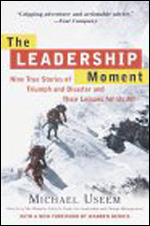 (Reprinted with permission of Sales and Marketing Management magazine, written by Erika Rasmusson.)
(Reprinted with permission of Sales and Marketing Management magazine, written by Erika Rasmusson.)
Organizations are made or broken by their leadership. One need look no further than an overboss like General Electric’s Jack Welch as proof. But what is it that makes or breaks a leader? What qualities enable a person to rise to a challenge and to make his or her voice heard?
The Leadership Moment: Nine True Stories of Triumph and Disaster and Their Lessons for Us All tries to answer these questions. Author Michael Useem, director of the Center for Leadership and Change Management at the Wharton School, examines nine accounts of leaders in their moments of truth, and identifies what enabled them to succeed or doomed them to fail. It is from these stories—which vary from a pharmaceutical head deciding the fate of a drug to a mountain climber guiding a group up the Himalayas—that readers can cull insights to help them prepare for their own leadership challenges. And, as Useem writes in his introduction, “We all need to be ready for those moments when our leadership is on the line, when the fate or fortune of others depends on what we do.”
Roy Vagelos certainly had the fate of others in his control when in 1978, as a lab director at pharmaceutical giant Merck, he approved development of a drug to prevent river blindness (a disease in which a parasite—carried by humpbacked black flies—spreads through the skin and into the eyes, causing progressive blindness). On the surface, Useem’s choice of Vagelos to open The Leadership Moment seems unimpressive. After all, developing new drugs is what pharmaceutical companies do. But Vagelos knew that those addicted with, or at risk of developing, river blindness—more than 85 million people in thirty-five developing countries—would never be able to afford Merck’s drug. By 1985, when Vagelos had been named CEO, the choice to manufacture the drug was his. What aided his decision? For one thing. Vagelos knew Merck’s history of fostering a culture that put “patients and customers first, company and shareholders second.” So when he couldn’t find any sponsors for the drug, Mectizan, Vagelos announced that Merck simply would give away the drug to all who needed it. “Sometimes in your life” he says in the book, “you’ve got to take a leadership position and make a decision.”
It was an expensive decision. More than a decade after the Vagelos go-ahead, “the lost income from the drug had reached $200 million or more—an investment that could have brought at least one commercially viable product to market.” But neither Vagelos nor Merck’s governing board ever second-guessed it.
The leadership lesson: Vagelos knew his own values, and knew they meshed with the company’s. That knowledge allowed him to make a decision that, while financially dubious, was culturally sound. “He knew that in assisting river blindness victims, he was ultimately building shareholder value,” Useem writes.
Not all of Useem’s stories are successes, however. The tale of Wagner Dodge, a Montana firefighter who led a crew of fifteen men to conquer a blaze in Mann Gulch, is replete with mistakes and misfortune. The crew had never fought a fire together; it lacked cohesiveness. And Dodge failed to gain the crew’s trust and compliance by making a series of erroneous decisions, and thirteen men perished. Useem’s lesson is that multiple mistakes call leadership ability into question, and that communication is key to compliance.
The Leadership Moment is refreshing in its philosophy that not all lessons of leadership need come from business leaders themselves—and not all leaders are to be emulated. The learning comes from recognizing what was—or wasn’t—done right, and applying it to one’s own leadership style.